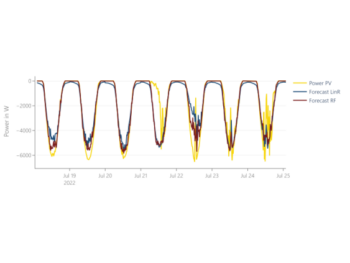Analyzing the Potential of grid-serving Flexibility – A novel approach to the synthesis of low-voltage grids
The aim of this article is to present a novel method that can be used to estimate low-voltage distribution grids at the municipality level. In addition, the simulation framework into which the method was integrated is briefly presented. In order to demonstrate the applicability of the method, the results of an analysis are presented, which estimates the expected increase in grid load in the low-voltage distribution grids due to the addition of new generation plants and consumption units, thereby highlighting the potential for grid-serving flexibility and innovative platform solutions.
Motivation and Objectives
The energy transition is one of the central building blocks for achieving the climate targets. Citizens play a special role in this venture. They can actively participate in the energy transition and invest in renewable energies, storage technologies, electric vehicles or heat pumps themselves. This way they move from being “simple” consumers towards prosumers who cover a large part of their electricity needs themselves and feed surpluses into the grid. They also have great potential for flexibility, which, according to [1], could reduce grid expansion costs of distribution grids by over 50% or €18 billion by 2035. A joint study by FfE and Agora [2] also concludes that the grid-friendly use of household-related flexibility can reduce the need for new transformers by 53% and the need for new power lines by 56%. Apart from Section 14a EnWG, which is intended purely as an emergency instrument, there are currently no incentives in Germany to use this flexibility to benefit the grid. Local energy markets that take grid restrictions into account are a promising way of leveraging this potential. They allow citizens to actively share their energy surpluses with neighbors, thus relieving the upper voltage levels and also marketing flexibility for congestion management in the low voltage grid level. The PEAK research project (funding code: 03E16035F) aims towards developing and testing a platform of this kind. Various scientific institutes as well as software companies and a grid operator are involved in the project for a practice-oriented implementation. In addition to the market design, FfE’s main focus in this project lays on analyzing the potential for decentralized energy markets.
Methodology
In order to assess the future increase in grid load and the associated flexibility potential, the grid load is determined in two scenarios at the level of the low-voltage grids. In the simplified “NoFlex” scenario, it is assumed that there are no home storage systems (HSS), domestic heat pumps (HP) or electric vehicles (EV) in the system. For rooftop PV systems (RPV) in the household sector, the 2019 stock is used in this scenario. In the scenario „Flex 2035“, a certain expansion of these assets and their non-flexible use is assumed. The differences between the two scenarios in terms of (peak) load enable a quantitative assessment of the increase in grid load. The resulting potential for flexible operation of the added technologies can therefore be shown.
Excursus: Simulation Framework
The simulation framework used was developed by FfE during the InDEED project and applied to evaluate use cases in the context of the digitalization and labelling of electricity. It is a tool that is able to create a digital twin of every municipality in Germany with information on buildings and households, renewable power plants as well as HSS, HP and EV based mainly on freely available data. This not only provides master data such as the location of a building or the installed capacity of a renewable power plant, but also regionally different load profiles in high temporal resolution. The simulation framework enables the application of custom scenarios. For EV, RPV, HP and HSS, either a total number, total installed capacity or a penetration rate must be specified for the municipality to be created. The tool can convert these inputs into individual assets and then assign them to the buildings so that master data and load profiles for RPV, HP, HSS and EV are available for each individual building. Details on the methodology and data sources of the simulation framework can be found in [3] and [4].
Scenario Flex 2035
The data for 2035 is based on the overarching figures for scenario B 2035 (2021 version) of the Grid Development Plan [5]. These overarching figures provide the installed capacity of RPV for Germany, as well as the number of EV, HSS and HP for the scenario. For use in the simulation framework, these must first be regionalized at municipal level. The regionalization according to [6] was selected for RPV. The overarching figures for HSS and HP were distributed to the municipalities based on the RPV regionalization. This means that municipalities with a high installed capacity of RPV receive a correspondingly high number of HSS and HP. The current number of EV per registration district can be found in the publications of the German Federal Motor Transport Authority [7]. This data was regionalized at municipal level based on the population from the census [8]. On the basis of the current number of EV at municipal level, the base figure of the Grid Development Plan for EV was distributed to the municipalities. After the regionalization of the overarching figures, the installed capacity of RPV and the numbers of HSS, HP and EV are available at municipality level and can be used in the simulation framework. All buildings with corresponding assets and load profiles are mapped with high spatial and temporal resolution. This was used, for example, in [4] to calculate the potential of regional direct marketing (see §9 StromStG) or the resulting prices in local energy communities. However, the local distribution grids were not taken into account there.
Clustering of buildings to low-voltage grids
In order to enable a simulation of the grid load at low-voltage level and due to the lack of availability of (geo)data for low-voltage grids, these are estimated at municipality level. For this purpose, a spatial clustering approach (Figure 1) from the field of unsupervised learning is used, which groups buildings based on the distance to neighbouring buildings (see also: FfE article series on the characterization of low-voltage grids). Each of the resulting building clusters represents an independent low-voltage grid. First, all buildings in a municipality are clustered using the density-based DBSCAN algorithm [9] with boundary conditions, e.g. for the maximum permitted distance between two buildings in the same cluster. A distance of 475 m was defined for the clustering. This value was derived from real world grid data (see below) by measuring the largest distance between two nearest neighbors for each network. The 95% quantile of this distribution corresponds to the above value and is assumed to be the plausible maximum distance between two buildings in the same grid area.

The following characteristics are determined for each of the resulting clusters:
- number of connection points in the entire grid area by counting all buildings in a cluster (assumption: one building corresponds to one connection point)
- yearly consumption in the grid area by adding up the household load of all buildings
- area of the grid coverage (corresponds to the area of the convex hull around all buildings in a cluster)
- average and maximum distance of a connection point to the transformer (assumption: position of the transformer is the centroid of the convex hull around all buildings)
- east-west and north-south expansion of the convex hull around all buildings in a cluster (i.e. the low-voltage grid area)
The same characteristics were collected in advance of the analysis for a (geo)data set of real-world low-voltage grids comprising several thousand grids. The plausibility of the synthetic low-voltage grids with regard to the selected characteristics is ensured by comparing these characteristics with those of the real grids. After the first clustering iteration (DBSCAN), clusters are often created that are deemed implausible due to too many buildings in the cluster. In a second step, these are further subdivided using the agglomerative clustering method (a type of hierarchical clustering) in order to achieve smaller clusters. After this process, the buildings in each plausible cluster are considered as part of an independent low-voltage grid.

Determining the grid load
Once the low-voltage grids have been established, the grid load is determined individually for each of them. For this purpose, hourly resolved load profiles of the individual generators and consumers are generated and linked using the simulation framework. The following load components are taken into account:
Household load
This load represents the electricity consumption of the household (excluding EV, HP, HSS). The load profiles were generated using the FfE household load profile generator [10] (details on use in the simulation framework can be found in [3]).
Charging profiles of electric vehicles
In addition to household load profiles, the household load profile generator also provides driving profiles linked to the households for vehicles of different vehicle classes (small, medium, large). These are used in the simulation framework to determine the charging times of EVs. In simplified terms, it is assumed that EVs start charging immediately on arrival at home and charge at full power until the battery is full or the next trip begins. A charging power of 11 kW and battery capacities of 20 kWh (small), 40 kWh (medium) and 60 kWh (large) were assumed for all EVs.
Heat Pumps
The thermal load profiles of the individual households also come from the household load profile generator. These are converted into electrical profiles for heat pumps according to [11] based on the outdoor temperature (at municipal level in hourly resolution) and assuming a coefficient of performance (COP) of three.
Rooftop PV systems and home storage systems
These technologies were included under the assumption of direct consumption. Surpluses from RPV (if available) are initially consumed directly to cover the household load, the load of the heat pump or for EV charging. If there is no demand within the household, surpluses are stored in the HSS if possible. Only if this is not possible is the surplus energy fed into the grid. Conversely, the electricity demand is always covered from the HSS (if available) before it is drawn from the grid.
These load profiles result in a residual load profile for each building, which shows for each hour of the year whether and how much the building feeds into the grid or draws from the grid. The residual load profiles of all the buildings in a low-voltage grid are added together to obtain the theoretical transformer load in the form of an hourly resolved residual load profile for the respective grid.
Sampling
The method was applied with the simulation framework to a sample of 10% of all municipalities in Germany (this corresponds to around 1,200 municipalities). The sample was taken from [4]. In this dissertation, the municipalities were first clustered according to energy industry criteria and then selected in such a way that each cluster is represented among the selected municipalities according to its cluster size. Sampling can thus save computational effort without over-representing a particular “municipality type” and distorting the result. By applying the clustering method to the sample of municipalities, around 70,000 synthetic low-voltage grids were generated and evaluated.
Results
If the load in the low-voltage grid exceeds the rated power of the transformers installed, these components can be damaged. As grid-side systems limit the power flow in this case, this is referred to as a grid congestion. Exceeding the current carrying capacity or exceeding voltage band limits also counts as a grid congestion, but was not taken into account in this simplified approach lacking an explicit load flow calculation. For an analysis of the transformer load, it is crucial to consider the total load in the subordinate low-voltage grid. As an indicator of congested grids, the average daily peak load per grid over the entire year is calculated for both scenarios. The peak load can be either a consumption or a generation peak in the load curve. If this value increases significantly from the “NoFlex” scenario to the scenario „Flex 2035“, this serves as an indicator of a prospectively increased load on the investigated grids. Figure 3 shows that the absolute level of the average daily peak load increases by more than 20 % (median) between the scenarios. While an increase of at least 9.5 % can be observed in 75 % of the examined grids, this value amounts to over 73 % in a quarter of the grids. While in the “NoFlex” scenario only around 2 % of the load peaks are caused by consumption, in the scenario with additional assets the figure is already 43 %, i.e. over 20 times as many. The additional load in the grids is therefore not only caused by the expansion of RPV, but also significantly by the additional loads.

In addition to the development of the peak load, its frequency of occurrence is also decisive. Therefore, the number of hours in which the load is higher than the average daily peak load is determined in both scenarios. The relative change in this value between the two scenarios is shown in Figure 4.

The frequency of hours during which the average daily peak load is exceeded therefore increases by almost 38 % (median). In 25 % of the grids examined, the number of hours doubles.
In addition to the frequency of load peaks over the year, their duration is also of particular importance, as a continuous overload due to heat development represents a more frequent risk for the equipment than short, isolated load peaks. This is due to the excessive heating of the equipment that occurs when limit values are exceeded, which causes accelerated ageing, which is why a prolonged overload due to thermal inertia can be more harmful to the equipment than a short overload with a higher output. For this purpose, the longest continuous sequence of hours with a load above the average daily peak load (see above) was determined for each low-voltage distribution grid. While the “NoFlex” scenario shows a median of four hours in a row with a correspondingly high load, this value amounts to six hours in the scenario „Flex 2035“ – an increase of 50 %. In 25 % of the examined grids, the value is seven hours or more. This is a further indicator of an increased grid load in the future.
The addition of RPV and other assets such as HP, HSS and EV not only leads to a significant increase in the average daily peak load in the synthetic low-voltage grids with the modeled demand-oriented operation, but also to a significantly more frequent occurrence of these load peaks. If one considers the increase in the average daily peak load by almost 75 % in a quarter of the grids examined, it is clear – even if the transformers are often oversized nowadays – that the current low-voltage distribution grids may reach their limits due to the addition of decentralized assets. At the same time, a great deal of demand-side flexibility is added to the grids through HP, HSS and EV compared to household consumption, which can potentially also be used to relieve the grid through suitable incentive mechanisms.
Mechanisms such as the PEAK platform provide specific financial incentives to flexibly shift individual power consumption in order to reduce the total load and thus give prosumers the opportunity to participate in the energy transition. Even if comprehensive upgrading is unavoidable, especially for the connection of decentralized generation plants, demand-oriented grid expansion measures can be delayed in some cases and inefficient expansion of the low-voltage grids “to the last kW” can be avoided.
Summary and outlook
The presented simulation framework and method in this article show that it is possible to derive plausible synthetic distribution grids (lacking grid topology and load flow simulation) on the basis of geodata and to use these to make nationwide statements on grid expansion requirements. In future, the tool can be used to analyze the costs of grid expansion requirements, the influence of new technologies and innovative business models, and to determine the effects on local prices or grid expansion needs in addition to market potential. For example, the effects and interactions of different dynamic electricity tariffs or time-variable grid charges can be analyzed across Germany or different concepts of energy communities (e.g. price mechanisms) can be evaluated. It is also possible to use the tool to identify regions in which there is a particular need for action or great potential in selected use cases.
However, it must also be taken into account that the synthesis of distribution grids in detail only reflects reality to a limited extent. As distribution grids have grown historically and are often oversized, the tool cannot replace a detailed analysis of individual distribution grids. In addition, the total load of the connections in the grid only reflects the transformer load. An actual load flow calculation is not performed, which is why the overloading of individual lines or voltage band violations are not taken into account. Therefore, individual distribution grid simulations should be consulted for an analysis of the lines or for questions that require a higher temporal resolution, as is possible in the GridSim model from FfE.
There are also currently still limitations in the modeling of controllable consumption facilities: Firstly, the simulation framework focuses on the “private households” sector, which is why the influence of trade and industry is ignored. Secondly, the model currently only assumes a demand-driven mode of operation for controllable installations. However, dynamic electricity tariffs, which will be rolled out as mandatory in Germany from 2025, can cause simultaneity due to price jumps and cause higher peak loads than assumed in the scenario described here.

Literature
[1] Özalay, Baris et al.: Wirtschaftlicher Vorteil der netzdienlichen Nutzung von Flexibilität in Verteilnetzen. Bonn: E-Bridge Consulting GmbH, 2019.
[2] Agora Energiewende und Forschungsstelle für Energiewirtschaft e. V. (2023): Haushaltsnahe Flexibilitäten nutzen. Wie Elektrofahrzeuge, Wärmepumpen und Co. die Stromkosten für alle senken können.
[3] Bogensperger, Alexander et al.: Comparison of Pricing Mechanisms in Peer-to-Peer Energy Communities. In: 12. Internationale Energiewirtschaftstagung (IEWT) 2021. Wien: Technische Universität Wien, 2021.
[4] Bogensperger, Alexander Johannes: Assessing the Potential of Multiple Use Cases for German Energy Communities via Integration of Machine Learning in the Energy-Economic Modeling Process. Dissertation. Herausgegeben durch Technische Universität München – TUM School of Engineering and Design der Technischen Universität München: München, 2023.
[5] Referat Netzentwicklung Stromübertragungsnetz: Genehmigung des Szenariorahmens 2021-2035. Bonn: Bundesnetzagentur für Elektrizität, Gas, Telekommunikation, Post und Eisenbahnen, 2020.
[6] Schmid, Tobias et al.: Regionalisierung des Ausbaus der Erneuerbaren Energien – Begleitdokument zum Netzentwicklungsplan Strom 2035 (Version 2021). München: Forschungsstelle für Energiewirtschaft e.V. (FfE), 2021.
[7] Fahrzeugzulassungen (FZ) – Bestand an Kraftfahrzeugen und Kraftfahrzeuganhängern nach Zulassungsbezirken; Flensburg: Kraftfahrt-Bundesamt, 2019.
[8] Zensusdatenbank des Zensus 2011: https://ergebnisse.zensus2011.de/; Wiesbaden: Statistische Ämter des Bundes und der Länder, 2013.
[9] Ester, Martin et al.: A density-based algorithm for discovering clusters in large spatial databases with noise. In: KDD-96 Proceedings; Munich: University of Munich, Institute für Computer Science, 1996.
[10] Müller, M.; Biedenbach, F.; Reinhard, J. Development of an Integrated Simulation Model for Load and Mobility Profiles of Private Households. Energies 2020, 13, 3843.
[11] Lastprofil Wärmepumpe. In: https://www.swm-infrastruktur.de/strom/netzzugang/bedingungen/waermepumpe. (Abruf am 2021-06-01); München: SWM Infrastruktur GmbH & Co. KG, 2021.


